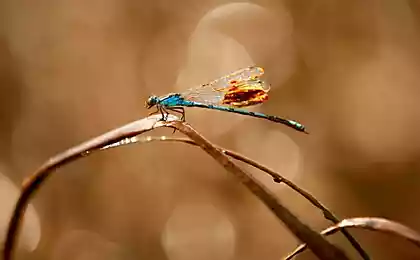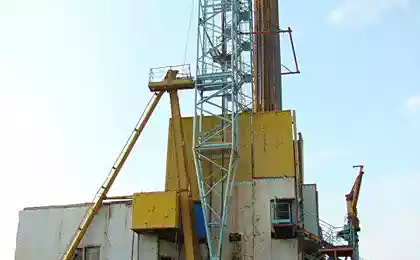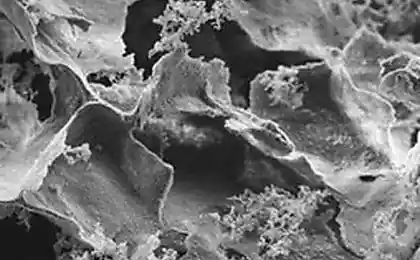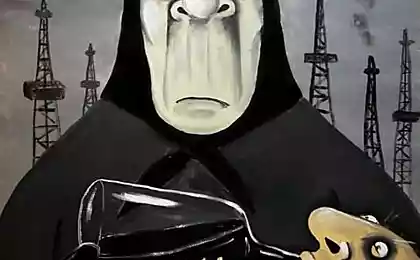1099
Educational program for the oil industry or the oil in plain language
Writes vl-ad-le-na:
What is the oil?
Oil - a mixture of liquid hydrocarbons: paraffins, aromatics and others. In fact, oil is not always black - and is green (Devonian, before I was in a jar, sorry, thrown out), brown (most common), and even white (transparent, like it is usual in the Caucasus).
Oil is divided by quality into several classes depending on the chemical composition - respectively, its price changes. Even in the oil very often associated dissolved gas, which is so brightly lit flares.
Gas may be diluted from 1 to 400 cubic meters per cubic meter of oil. That is dofiga. Sam, this gas consists mainly of methane, but because of the difficulty of its preparation (it should be dry, clean and prepare to bring to the Wobbe Index - to be strictly defined calorific value) of associated gas is rarely used for domestic purposes. Roughly speaking, if the gas from the field to put in the gas stove in the apartment, the consequences could be soot on the ceiling before the death tainted sheets and poisoning (eg, hydrogen sulfide).
Oh yes. Another tailwind in the muck of oil - dissolved hydrogen sulfide (because oil - organic matter). It is very poisonous and highly corrosive activity. This imposes constraints on oil production. Oil production. Professionalism, which I, by the way, do not drink alcohol.

Where did the oil?
At this point there are two theories (for details - here). One - inorganic. It was first proposed by Mendeleev and is that hot water flows past the metal carbides, and thereby form hydrocarbons. The second - the organic theory. It is believed that the oil "matured", usually in the sea and lagoon conditions by digestion of organic residues animals and plants (sludges) in certain temperature and pressure conditions (high pressure and temperature). In fact, studies confirm this theory.
Why geology?
It should probably be mentioned structure of our Earth. In my opinion, the picture all nice and clear.
So, petroleum geologists are only concerned with the Earth's crust. It consists of crystalline basement (where the oil is sooooo rare, as it is igneous and metamorphic rocks) and the sedimentary cover. The sedimentary cover is composed of sedimentary rocks, but will not go into geology. I can only say that the depth of oil wells is typically of the order of 500 - 3500 m. Here at this depth and is oil. Usually just above water, below - the crystalline basement. The deeper the rock - the sooner it is deposited, which is logical.

Where lies the oil?
Contrary somehow common myths about the "oil lakes" under the ground, oil is trapped. Simplifying traps in vertical section look like (water - the eternal companion of oil):

(Tuck, arched "back" up, called anticline. And if it looks like a bowl - a syncline in synclines oil is not delayed).
Or this: (see. Figure)
A plan may be circular or oval raised. Dimensions - from hundreds of meters to hundreds of kilometers. One or more of these traps near are the oil field.
Since oil is lighter than water, it floats up. But that oil is not leaked anywhere else (right, left, up or down), with its reservoir should be limited rocks above and below the tire. This usually clay or dense carbonates salts.
Where are the bends in the earth's crust? It rocks laid horizontally or almost horizontally? (if they are laid in groups, these heaps are usually quickly leveled by wind and water). And bends - raising, lowering - are due to tectonics. Have you seen the picture of the Earth with a cut of the word "turbulent convection"? This most convection moves lithospheric plates that leads to the formation of cracks in the plates, and hence the block offset between cracks and changes in the internal structure of the Earth.

This is the core - drilled a piece of rock. Tight sandstone. The depth of 1800 m. Oil it does not.
Another important addition - nature abhors a vacuum. Virtually all of the porous and permeable rock is usually saturated with water, i.e. in their pores is water. Salt, as it flows through a lot of minerals. And it is logical that some of these minerals is carried away with the water in dissolved form, and then changing temperature and pressure conditions, falls in most of these pores. Thus, the grains become bonded rock salts and a process called cementing. That is why, by and large, well do not fall off immediately in the drilling process - because the rocks are cemented.

How to find oil?
Usually first seismic: let the fluctuations on the surface (the explosion, for example) and measure the time of their return by the receivers.
Next time the return wave is calculated depth of a horizon at different points on the surface and build maps. If the card is detected lifting (= anticlinal trap), it is checked for the presence of oil drilling. Not all traps have oil.

As wells are drilled?
Well - it is a vertical excavation with a length many times greater than the width.
Two facts about wells: 1. They are deep. 2. They are narrow. The average diameter of the well at the entrance to the reservoir - about 0, 2-0, 3 m. That is, to a person not fit unambiguously. Average depth - as already mentioned, 500-3500 m.
Well is being drilled with the drilling rig. There is a tool for crushing the rock as a chisel. Note, not the drill. And it is absolutely not similar to most helical device from "Teenage Mutant Ninja Turtles».
Chisel suspended on drill pipe and spinning - it is pressed to the bottom of the well the weight of these same tubes. There are various principles for driving the bit in motion, but generally all rotate the drill string to the bit and spun their teeth milled rock. Also continuously injected into the well (inside the drill pipe) and is evacuated (between the borehole wall and the outer wall of the pipe) drilling fluid - in order to cool the whole structure and carry away particles of crushed rock.
What is the tower? To hang on it the best drill pipe (in fact in the process of drilling the upper end of the column is lowered, and it must be screwing the new pipes) and to raise the pipe string to replace the bit. Drilling of one well takes about a month. Sometimes a special ring bit that when drilling leaves the central column of the breed - Cairn. Kern is taken to study the properties of rocks, although it is expensive. More wells are inclined and horizontal.

How do I know where a layer of lies?
A person can not go down into the well. But we also need to know that we have drilled there? When a well is drilled, it is lowered onto the cable geophysical probes. These probes are working on a completely different physical principle - the intrinsic polarization, induction, resistance measurement, gamma radiation, neutron radiation, the measurement of the diameter of the well, etc. All curves recorded in the files, it turns out that's a nightmare:
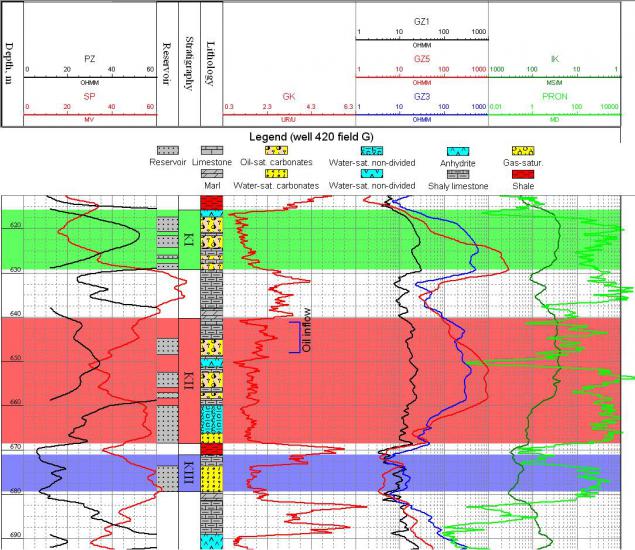
Now enter the work in geophysics. Knowing the physical characteristics of each breed, they secrete layers of lithology - sandstones, carbonates, clay - and stake the cut on the stratigraphy (ie, to what age and time that the reservoir). I think about Jurassic Park heard everything (see. Tab.)
In fact, there is much more detailed partition cut into tiers, horizon, bands, etc. - But it does not matter to us now. It is important that the oil reservoir (reservoirs capable to give oil) are of two types: carbonates (limestone, chalk, for example) and clastic (sand, cemented only). Carbonates - is CaCO3. Terrigenous - SiO2. That is, if rough. To say which is better, it is impossible, they are different.
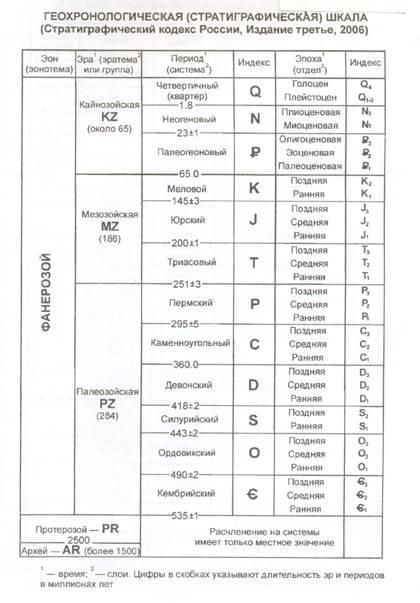
How well prepared to work?
Once the well is drilled, cased it. This means - let down a long column of steel casing (diameter almost as a well), and then into the space between the borehole wall and the outer wall of the pipe is pumped ordinary cement. This is to ensure that the well was not showered (after all, not all breeds are well cemented). The borehole is now looks like this:

But we closed the casing and cement layer you want us to! Therefore, the perforation is performed in front of the formation of the column (and how to know where to formation? Geophysicist!). Down, again, to hammer on the cable laid in a explosive charge. There charges are triggered and formed perforation holes and channels. Now we do not care about the water from nearby reservoirs - we perforated the well just across from the right.

How to extract oil?
The most interesting part, I think. The oil is much more viscous than water. I think that is a strength - understood intuitively. Some oil bitumen, for example, similar in viscosity butter.
Zayd from the other end. The fluids in the reservoir under pressure - they are pushing the overlying rock layers. And when we drill the well - from the well is not pressing anything. That is, in the area of low pressure wells. Differential pressure is created, called the depression, and that it leads to the fact that the oil starts to flow towards the hole and to appear in it.
To describe the flow of oil, there are two simple equations that need to know all the oil.
Darcy equation for a straight stream:

Dupuis equation for plane radial flow (just in case inflow to the well):
In fact, for them and stand. Then delve into physics and write the equation of unsteady inflow is not necessary.

From a technical point of view, the most common are three ways of oil production.
Fountain. This is when the reservoir pressure is very high, and not just the oil flows into the well, but also rises to the top and poured it (well, not really shimmers and the chimney - and further).
SRP pump (sucker rod pumps) and ESP (electric centrifugal pump). The first case - it is a regular pumping unit.

The second surface is absolutely not visible:
Note towers there. The tower is needed only for the descent / ascent pipe in the well, but not for extraction.
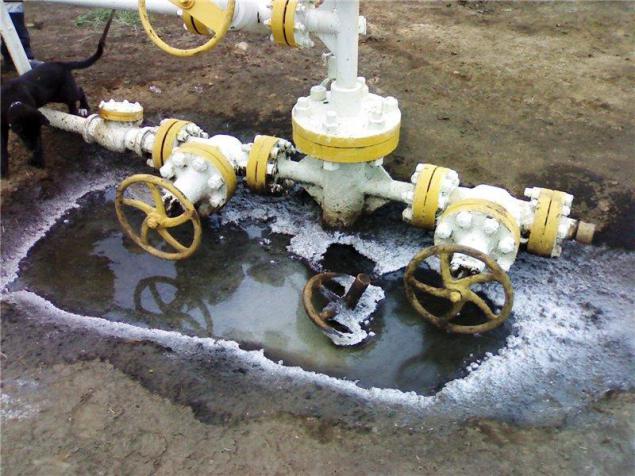
The essence of the pumps is simple: creating additional pressure to the fluid received by the well, the well would rise to the surface of the earth.
It is worth remembering the usual glass of water. As we drink from it? Cant, right? But well tilt fail. But in a glass of water can be omitted and drinking straw through it, pulling the liquid by mouth. Approximately so well and work: its walls - the walls of the glass tube and instead lowered into the well string of tubing (NKT). Oil rises on pipes.

In the case of SRP pumping unit moves its "head" up and down, respectively, driving the post. The boom in moving up drags the pump (bottom valve open), and when driving the pump is lowered down (opens the upper valve). So, little by little, the liquid rises.
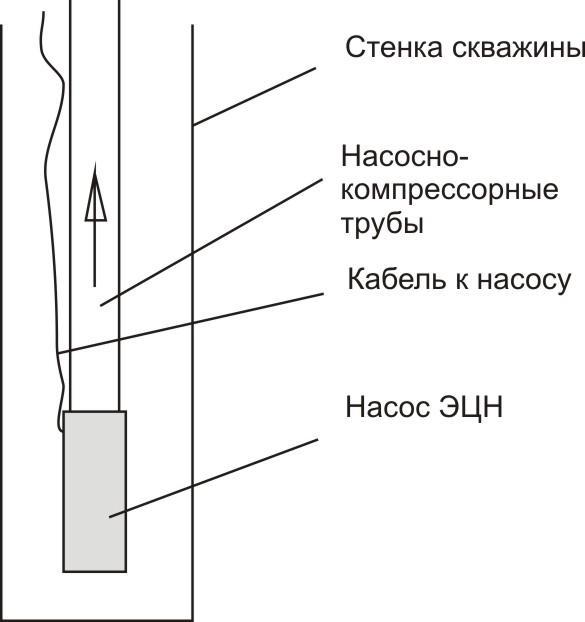
ESP operates directly on electricity (with the engine, of course). Inside the pump spinning wheel (horizontal), they have slots, so oil and rises to the top.
I should add that the open gushing oil, which like to show in cartoons - it's not just an emergency situation, but also an ecological disaster and millions in fines.

What to do when the oil is extracted is bad?
Over time, the oil ceases to be squeezed out of the rock under the weight of overlying strata. Then the work enters the system RPM - to maintain reservoir pressure. Injection wells are drilled, and water is pumped into them under high pressure. Naturally, pumped or produced water, sooner or later fall into the production wells and will climb up along with oil.
Yet it should be noted that the larger the share of oil in the flow, the faster it flows, and vice versa. Therefore, the more water flows together with the oil, the harder the oil out of the pores and into the wellbore. The dependence of the share of the oil permeability of the proportion of water in the stream is presented below and is called the relative permeability curves. Too much-needed concept for oil.
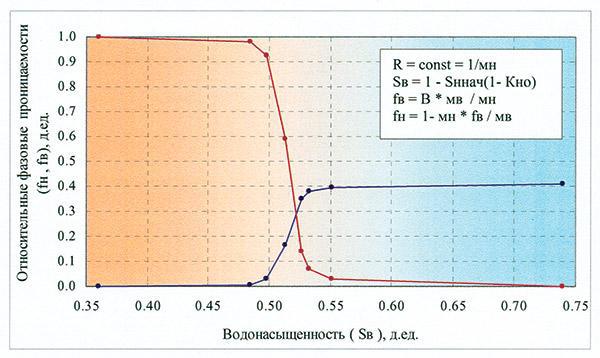
If the bottom-hole formation zone dirty (fine rock particles entrained with the oil, or dropped hard paraffins), it is carried out acid treatment (the well is stopped and it is pumped into a small amount of hydrochloric acid) - this process is good for carbonate formations because they dissolve. For clastic (sandstone) acid do not care. Therefore, they carried the fracture - wellbore in rock gel under very high pressure, so that the reservoir begins to crack in the vicinity of the well, then pumped proppant (ceramic balls or coarse sand to not crack is closed). After that, the well starts to work much better, because it prevents the flow of liquidated.
What happens next with the oil when it is extracted?
First, the oil rises to the surface in a tube that goes from each well. 10-15 wells surrounding these pipes are connected to one measuring device, which is measured by how much oil is produced. Then the oil goes to the training standards of guests: from it are removed salt, water, mechanical impurities (fine particles of rock), if necessary, and hydrogen sulfide, as well as oil razgaziruetsya completely to atmospheric pressure (you remember that oil can be dofiga gas?). Trading oil enters the refinery. But the plant may be far away, and then in the case enters the company "Transneft" - pipelines for the finished oil (as opposed to commercial pipelines for crude oil and water). The pipeline oil swings exactly the same ESP-s, only the position of one side. They just rotating impellers.
The separated oil from water is pumped back into the reservoir, the gas is flared or going to the gas processing plant. And oil is either sold (abroad pipelines or tankers), or goes to a refinery, where distilled by heating: light fractions (gasoline, kerosene, naphtha) are fuel, heavy paraffinic - raw material for plastics, etc. and the heaviest fuel oil with a boiling point above 300 degrees usually serve as fuel for boilers.
How it regulated?
For oil production has two main project documents: a draft calculation of reserves (there is justified that the oil in the reservoir so much and no more, no less) and project development (there describes the history of the field and prove that it is necessary to design it that way, rather than otherwise).
For the calculation of reserves built geological models, and for the development project - hydrodynamic (it is calculated as the field will operate in a particular mode).
How much all this costs?
I must say, all prices are usually confidential. But I can say about: Samara well worth 30-100 million. depending on the depth. A ton of the commodity (non-recycled) oil is different. Once considered the first degree, gave a value of about 3000 p., When the second - about 6000 r., The difference in time - a year, but this may not be the actual values. Now I do not know. Taxes make up at least 40% of the profits, plus property tax (depending on the carrying value of the property), plus tax on mining. Add the money required to pay employees for electricity, to repair wells and field development - construction of pipelines and equipment for the collection and treatment system. Very often, the economy development projects goes to the negative, so we must contrive to work a plus.
I add such a thing as discounting - ton of oil extracted in the next year, less valuable than a ton of oil extracted in this. Therefore, an enhanced oil recovery (which also costs money).
So, I briefly outlined what she studied for 6 years. The whole process, from the appearance of the oil in the reservoir, exploration, drilling, production, refining and transportation to the sale - you can see that this requires a completely different profiles specialists. I hope that at least someone will read this very long post - and I'm cleansed conscience and disperse at least a few myths surrounding oil.
via vl-ad-le-na.livejournal.com

Source:
What is the oil?
Oil - a mixture of liquid hydrocarbons: paraffins, aromatics and others. In fact, oil is not always black - and is green (Devonian, before I was in a jar, sorry, thrown out), brown (most common), and even white (transparent, like it is usual in the Caucasus).
Oil is divided by quality into several classes depending on the chemical composition - respectively, its price changes. Even in the oil very often associated dissolved gas, which is so brightly lit flares.
Gas may be diluted from 1 to 400 cubic meters per cubic meter of oil. That is dofiga. Sam, this gas consists mainly of methane, but because of the difficulty of its preparation (it should be dry, clean and prepare to bring to the Wobbe Index - to be strictly defined calorific value) of associated gas is rarely used for domestic purposes. Roughly speaking, if the gas from the field to put in the gas stove in the apartment, the consequences could be soot on the ceiling before the death tainted sheets and poisoning (eg, hydrogen sulfide).
Oh yes. Another tailwind in the muck of oil - dissolved hydrogen sulfide (because oil - organic matter). It is very poisonous and highly corrosive activity. This imposes constraints on oil production. Oil production. Professionalism, which I, by the way, do not drink alcohol.

Where did the oil?
At this point there are two theories (for details - here). One - inorganic. It was first proposed by Mendeleev and is that hot water flows past the metal carbides, and thereby form hydrocarbons. The second - the organic theory. It is believed that the oil "matured", usually in the sea and lagoon conditions by digestion of organic residues animals and plants (sludges) in certain temperature and pressure conditions (high pressure and temperature). In fact, studies confirm this theory.
Why geology?
It should probably be mentioned structure of our Earth. In my opinion, the picture all nice and clear.
So, petroleum geologists are only concerned with the Earth's crust. It consists of crystalline basement (where the oil is sooooo rare, as it is igneous and metamorphic rocks) and the sedimentary cover. The sedimentary cover is composed of sedimentary rocks, but will not go into geology. I can only say that the depth of oil wells is typically of the order of 500 - 3500 m. Here at this depth and is oil. Usually just above water, below - the crystalline basement. The deeper the rock - the sooner it is deposited, which is logical.

Where lies the oil?
Contrary somehow common myths about the "oil lakes" under the ground, oil is trapped. Simplifying traps in vertical section look like (water - the eternal companion of oil):

(Tuck, arched "back" up, called anticline. And if it looks like a bowl - a syncline in synclines oil is not delayed).
Or this: (see. Figure)
A plan may be circular or oval raised. Dimensions - from hundreds of meters to hundreds of kilometers. One or more of these traps near are the oil field.
Since oil is lighter than water, it floats up. But that oil is not leaked anywhere else (right, left, up or down), with its reservoir should be limited rocks above and below the tire. This usually clay or dense carbonates salts.
Where are the bends in the earth's crust? It rocks laid horizontally or almost horizontally? (if they are laid in groups, these heaps are usually quickly leveled by wind and water). And bends - raising, lowering - are due to tectonics. Have you seen the picture of the Earth with a cut of the word "turbulent convection"? This most convection moves lithospheric plates that leads to the formation of cracks in the plates, and hence the block offset between cracks and changes in the internal structure of the Earth.

This is the core - drilled a piece of rock. Tight sandstone. The depth of 1800 m. Oil it does not.
Another important addition - nature abhors a vacuum. Virtually all of the porous and permeable rock is usually saturated with water, i.e. in their pores is water. Salt, as it flows through a lot of minerals. And it is logical that some of these minerals is carried away with the water in dissolved form, and then changing temperature and pressure conditions, falls in most of these pores. Thus, the grains become bonded rock salts and a process called cementing. That is why, by and large, well do not fall off immediately in the drilling process - because the rocks are cemented.

How to find oil?
Usually first seismic: let the fluctuations on the surface (the explosion, for example) and measure the time of their return by the receivers.
Next time the return wave is calculated depth of a horizon at different points on the surface and build maps. If the card is detected lifting (= anticlinal trap), it is checked for the presence of oil drilling. Not all traps have oil.

As wells are drilled?
Well - it is a vertical excavation with a length many times greater than the width.
Two facts about wells: 1. They are deep. 2. They are narrow. The average diameter of the well at the entrance to the reservoir - about 0, 2-0, 3 m. That is, to a person not fit unambiguously. Average depth - as already mentioned, 500-3500 m.
Well is being drilled with the drilling rig. There is a tool for crushing the rock as a chisel. Note, not the drill. And it is absolutely not similar to most helical device from "Teenage Mutant Ninja Turtles».
Chisel suspended on drill pipe and spinning - it is pressed to the bottom of the well the weight of these same tubes. There are various principles for driving the bit in motion, but generally all rotate the drill string to the bit and spun their teeth milled rock. Also continuously injected into the well (inside the drill pipe) and is evacuated (between the borehole wall and the outer wall of the pipe) drilling fluid - in order to cool the whole structure and carry away particles of crushed rock.
What is the tower? To hang on it the best drill pipe (in fact in the process of drilling the upper end of the column is lowered, and it must be screwing the new pipes) and to raise the pipe string to replace the bit. Drilling of one well takes about a month. Sometimes a special ring bit that when drilling leaves the central column of the breed - Cairn. Kern is taken to study the properties of rocks, although it is expensive. More wells are inclined and horizontal.

How do I know where a layer of lies?
A person can not go down into the well. But we also need to know that we have drilled there? When a well is drilled, it is lowered onto the cable geophysical probes. These probes are working on a completely different physical principle - the intrinsic polarization, induction, resistance measurement, gamma radiation, neutron radiation, the measurement of the diameter of the well, etc. All curves recorded in the files, it turns out that's a nightmare:

Now enter the work in geophysics. Knowing the physical characteristics of each breed, they secrete layers of lithology - sandstones, carbonates, clay - and stake the cut on the stratigraphy (ie, to what age and time that the reservoir). I think about Jurassic Park heard everything (see. Tab.)
In fact, there is much more detailed partition cut into tiers, horizon, bands, etc. - But it does not matter to us now. It is important that the oil reservoir (reservoirs capable to give oil) are of two types: carbonates (limestone, chalk, for example) and clastic (sand, cemented only). Carbonates - is CaCO3. Terrigenous - SiO2. That is, if rough. To say which is better, it is impossible, they are different.

How well prepared to work?
Once the well is drilled, cased it. This means - let down a long column of steel casing (diameter almost as a well), and then into the space between the borehole wall and the outer wall of the pipe is pumped ordinary cement. This is to ensure that the well was not showered (after all, not all breeds are well cemented). The borehole is now looks like this:

But we closed the casing and cement layer you want us to! Therefore, the perforation is performed in front of the formation of the column (and how to know where to formation? Geophysicist!). Down, again, to hammer on the cable laid in a explosive charge. There charges are triggered and formed perforation holes and channels. Now we do not care about the water from nearby reservoirs - we perforated the well just across from the right.

How to extract oil?
The most interesting part, I think. The oil is much more viscous than water. I think that is a strength - understood intuitively. Some oil bitumen, for example, similar in viscosity butter.
Zayd from the other end. The fluids in the reservoir under pressure - they are pushing the overlying rock layers. And when we drill the well - from the well is not pressing anything. That is, in the area of low pressure wells. Differential pressure is created, called the depression, and that it leads to the fact that the oil starts to flow towards the hole and to appear in it.
To describe the flow of oil, there are two simple equations that need to know all the oil.
Darcy equation for a straight stream:

Dupuis equation for plane radial flow (just in case inflow to the well):
In fact, for them and stand. Then delve into physics and write the equation of unsteady inflow is not necessary.

From a technical point of view, the most common are three ways of oil production.
Fountain. This is when the reservoir pressure is very high, and not just the oil flows into the well, but also rises to the top and poured it (well, not really shimmers and the chimney - and further).
SRP pump (sucker rod pumps) and ESP (electric centrifugal pump). The first case - it is a regular pumping unit.

The second surface is absolutely not visible:
Note towers there. The tower is needed only for the descent / ascent pipe in the well, but not for extraction.

The essence of the pumps is simple: creating additional pressure to the fluid received by the well, the well would rise to the surface of the earth.
It is worth remembering the usual glass of water. As we drink from it? Cant, right? But well tilt fail. But in a glass of water can be omitted and drinking straw through it, pulling the liquid by mouth. Approximately so well and work: its walls - the walls of the glass tube and instead lowered into the well string of tubing (NKT). Oil rises on pipes.

In the case of SRP pumping unit moves its "head" up and down, respectively, driving the post. The boom in moving up drags the pump (bottom valve open), and when driving the pump is lowered down (opens the upper valve). So, little by little, the liquid rises.

ESP operates directly on electricity (with the engine, of course). Inside the pump spinning wheel (horizontal), they have slots, so oil and rises to the top.
I should add that the open gushing oil, which like to show in cartoons - it's not just an emergency situation, but also an ecological disaster and millions in fines.

What to do when the oil is extracted is bad?
Over time, the oil ceases to be squeezed out of the rock under the weight of overlying strata. Then the work enters the system RPM - to maintain reservoir pressure. Injection wells are drilled, and water is pumped into them under high pressure. Naturally, pumped or produced water, sooner or later fall into the production wells and will climb up along with oil.
Yet it should be noted that the larger the share of oil in the flow, the faster it flows, and vice versa. Therefore, the more water flows together with the oil, the harder the oil out of the pores and into the wellbore. The dependence of the share of the oil permeability of the proportion of water in the stream is presented below and is called the relative permeability curves. Too much-needed concept for oil.

If the bottom-hole formation zone dirty (fine rock particles entrained with the oil, or dropped hard paraffins), it is carried out acid treatment (the well is stopped and it is pumped into a small amount of hydrochloric acid) - this process is good for carbonate formations because they dissolve. For clastic (sandstone) acid do not care. Therefore, they carried the fracture - wellbore in rock gel under very high pressure, so that the reservoir begins to crack in the vicinity of the well, then pumped proppant (ceramic balls or coarse sand to not crack is closed). After that, the well starts to work much better, because it prevents the flow of liquidated.
What happens next with the oil when it is extracted?
First, the oil rises to the surface in a tube that goes from each well. 10-15 wells surrounding these pipes are connected to one measuring device, which is measured by how much oil is produced. Then the oil goes to the training standards of guests: from it are removed salt, water, mechanical impurities (fine particles of rock), if necessary, and hydrogen sulfide, as well as oil razgaziruetsya completely to atmospheric pressure (you remember that oil can be dofiga gas?). Trading oil enters the refinery. But the plant may be far away, and then in the case enters the company "Transneft" - pipelines for the finished oil (as opposed to commercial pipelines for crude oil and water). The pipeline oil swings exactly the same ESP-s, only the position of one side. They just rotating impellers.
The separated oil from water is pumped back into the reservoir, the gas is flared or going to the gas processing plant. And oil is either sold (abroad pipelines or tankers), or goes to a refinery, where distilled by heating: light fractions (gasoline, kerosene, naphtha) are fuel, heavy paraffinic - raw material for plastics, etc. and the heaviest fuel oil with a boiling point above 300 degrees usually serve as fuel for boilers.
How it regulated?
For oil production has two main project documents: a draft calculation of reserves (there is justified that the oil in the reservoir so much and no more, no less) and project development (there describes the history of the field and prove that it is necessary to design it that way, rather than otherwise).
For the calculation of reserves built geological models, and for the development project - hydrodynamic (it is calculated as the field will operate in a particular mode).
How much all this costs?
I must say, all prices are usually confidential. But I can say about: Samara well worth 30-100 million. depending on the depth. A ton of the commodity (non-recycled) oil is different. Once considered the first degree, gave a value of about 3000 p., When the second - about 6000 r., The difference in time - a year, but this may not be the actual values. Now I do not know. Taxes make up at least 40% of the profits, plus property tax (depending on the carrying value of the property), plus tax on mining. Add the money required to pay employees for electricity, to repair wells and field development - construction of pipelines and equipment for the collection and treatment system. Very often, the economy development projects goes to the negative, so we must contrive to work a plus.
I add such a thing as discounting - ton of oil extracted in the next year, less valuable than a ton of oil extracted in this. Therefore, an enhanced oil recovery (which also costs money).
So, I briefly outlined what she studied for 6 years. The whole process, from the appearance of the oil in the reservoir, exploration, drilling, production, refining and transportation to the sale - you can see that this requires a completely different profiles specialists. I hope that at least someone will read this very long post - and I'm cleansed conscience and disperse at least a few myths surrounding oil.
via vl-ad-le-na.livejournal.com

Source:




